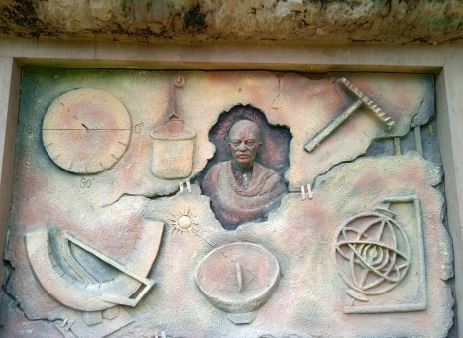Pathani Samanta: Odisha’s Naked-Eye Astronomer & His Accurate Calculations With ‘Manayantra’

Bhubaneswar: Chief Minister Naveen Patnaik on Wednesday paid tributes to astrologer Pathani Samanta on his birth anniversary.
“His research and contribution to the field of astronomy is incomparable. His invaluable book ‘Siddhanta Darpan’ has always been an inspiration in the field of astrology,” he posted on X.
The genius Chandra Sekhar Singh Samanta, popular as Pathani Samanta in Odisha, was born in 1835 at Khandapada now in Nayagarh district. He hailed from a royal family.
According to wall murals at Pathani Samanta Planetarium in Bhubaneswar, his parents sought the help of a Muslim fakir, who adopted him, after the loss of two daughters and one son in infancy. To ward off any remaining traces of the evil eye, and in memory of the fakir who saved their son’s life, the couple nicknamed him ‘Pathani’.
He developed an interest in stargazing at a very young age. A heedful observer, who was homeschooled in Sanskrit and Mathematics, he measured the position and speed of the celestial objects with his naked eye and using a self-made instrument called ‘Manayantra’ between the age of 11 and 23.
Here is more about this underrated genius:
>> Chandra Sekhar was well known in India and beyond for his accurate astronomical calculations, new theories about the planets, their movements which were based on observations made by his naked eyes or with primitive instruments designed by himself. His self-made bamboo sticks could easily rival even the complex telescopes of today’s era in their accuracy.
>> He used to stay awake all night and observe the motion of all the planets around the sky.
>> He observed, verified and corrected all that was known to the Hindu astronomers for thousand of years. Even on many occasions he went beyond them to discover new phenomena, formulations and came out with predictions which as per his claim will remain valid for at least next ten thousand years.
>> He recorded all of his findings in ‘Siddhanta Darpan’, a small book with about 2500 verses (24 chapters) in Sanskrit language entirely written on palm-leaves. At the end of his treatises, he has furnished the calculations of an almanac which has been named as ‘Kautuka Panjee’.
>> Published in 1899, ‘Siddhanta Darpan’ is used to prepare the almanacs or the Hindu Panchang/ Panji/ Panjika in Odisha even till date and have stood the test of time in successfully predicting eventful occasions like eclipses. The book also found mention in the prestigious British journal ‘Nature’ and the American journal ‘Knowledge’.
>> Pathani Samanta quoted that the time required for earth to complete one revolution around Sun is 365.25843 days while modern computers put the figure at 365.25636 days. Apart from this, he calculated that the inclination of the orbit of Moon’s around earth is 5 Degree 09 minutes while modern computers put it at 5 degree 08 minutes and 33 seconds.
>> He calculated the irregularities of Moon’s motion when it orbits around the earth which no astronomer in India had done till then. He proved that Moon’s motion when it orbits around 27 Nakshatras (starting from Aswini and ending with Revati) is not uniform even though every Nakshatra occupies 13 Degrees 20 minutes in the open sky. Therefore, Moon slows down while transiting in Rohini Nakshatra compared to other Nakshatras.
>> Chandra Sekhar innovated three principles – Tungatanra, Pakshika and Digamsa – to know the exact longitude of moon. These three formulas expounded by him are very correct and they hold good in every respect. Likewise, he had devised many new formulas for ascertaining the exact longitude of all the planets. His formulas regarding the solar and lunar eclipse are still invaluable in the astronomical treasury.
>> His ability to prepare ‘Manayantra’ (measuring instrument), ‘Golyantra’ (spherical instrument) and ‘Surya-Ghadi’ (Sun dial to measure the time) proved that he was a good architect with engineering skill.
>> He is rightly called the second Bhaskara in India and seems to be the last link in the long order of great Hindu astronomers like Aryabhatta, Varahamihira, Brahma Gupta and Bhaskara.
>> Because of his astronomical and astrological achievements, the British government had conferred him the title of ‘Mahamahopadhyay’ in 1893 and the King of Puri had conferred him the title of ‘Harichandan Mahapatra’. The planetarium in Bhubaneswar is named after him.
>> As per his own prediction, he came all the way to Jagannath Temple of Puri to breathe his last on June 11, 1904, at the age of 69

Comments are closed.